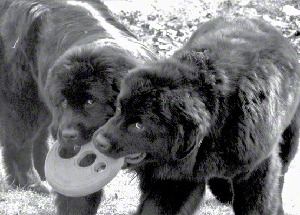Socializing your puppy of course means your dog will come into contact with other dogs, and no socialization program is complete if it does not give your Newfoundland the opportunity to interact freely with other canines. Because such interactions are likely to be a part of your dog’s entire life, it’s important to know what “good” interaction between dogs looks like.
Of course, a brief note like this cannot explore the complexities of canine interaction, and you are encouraged to look into any of the many good books and other resources discussing appropriate dog interactions and what to look for, but a few basic tips can help get you started. Young dogs may be hesitant around older, larger dogs, so the fact your puppy doesn’t immediately rush into a game of chase or rough and- tumble may only mean that he or she needs a few minutes to get adjusted to a new scene and new activities, so don’t immediately assume your puppy isn’t up for any social interaction. At the same time, never force your dog into an interaction with another dog; that’s a recipe for trouble. Let your dog tell you what he or she is comfortable with. Dogs that don’t want to interact with other dogs will typically look away from the other dog, almost as though they are pretending the other dog is not there, so that’s a reliable sign to watch for.
It’s normal for dogs to approach each other a bit hesitantly, often approaching with a “sideways” movement – that’s a good start, for it means the dog is exposing itself, which in the canine world is an appeasement gesture, signaling that there are no hostile intentions. While a wagging tail is often taken for another friendly gesture – and it often is exactly that – don’t rely on that exclusively for evidence that your dog, or the dog your puppy is interacting with, is “happy” and ready to play nicely. That may well be the case, but dogs sometimes wag their tails under the influence of other emotions, not all of them quite so positive.
Of course the most well-known and recognizable sign of friendly play is the famous “play bow,” in which the dog will lower the front of its body while spreading its front legs forward and out. (In some dogs this gesture is dramatically evident; in others, it can be fairly subtle.) This is an invitation to play and usually signals good times ahead, but always supervise any play in which your puppy is involved. Even friendly play sessions with well-socialized dogs can at times turn rough, so never let your dog play with another dog unsupervised. Be aware that even friendly play can seem surprisingly rough to humans who don’t have lots of experience watching dogs interact freely; even the most innocent and well-meaning dog play can involve flashing teeth, barking, the occasional growl, body slams, and more.
Again, a brief note like this can only brush the surface of a complex matter on which even experts do not always agree. The best thing a new puppy owner can do is seek out additional information (the works of highly respected animal behaviorists such as Patricia McConnell and Stanley Coren are an excellent place to start) and, always, closely watch his or her dog and – in a twist on the usual advice for living with dogs – follow your dog’s lead.

